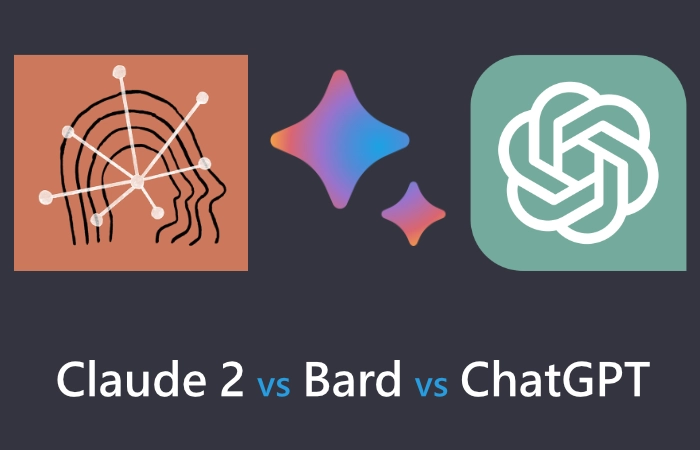The landscape of language models is becoming increasingly diverse and complex. This guide aims to provide a quick comparison of three of the most prominent models currently available Claude 2 vs Bard vs ChatGPT . Each of these models has its unique strengths and areas of enhancement, and understanding these differences can help users extract the best from these powerful tools.
Claude 2
Claude 2 represents a significant advancement in conversational AI, not just in terms of performance but also in its scope of functionality and ethical considerations. One of the key improvements is its enhanced performance, evidenced by metrics like its score on the Bar exam’s multiple-choice section, which went up to 76.5% from 73.0% in the previous version, Claude 1.3. This indicates a stronger ability in legal reasoning and understanding of law, which can be invaluable for businesses and individuals seeking quick consultations.
Moreover, Claude 2 has shown exceptional prowess in standardized tests like the GRE, where it scores above the 90th percentile in reading and writing. The quantitative reasoning scores are on par with the median applicant for graduate school. These metrics are suggestive of Claude 2’s well-rounded abilities in various subjects, including coding, math, and reasoning, providing a robust platform that can assist in a multitude of tasks.
Accessibility and user experience are also focal points in Claude 2’s development. Besides being accessible via API for business applications, Claude has expanded its reach through a new public-facing beta website, claude.ai. This allows a broader audience to benefit from its capabilities explains Anthropic AI the creators of Claude.
What sets Claude 2 apart further is its user feedback, which emphasizes ease of conversation and reduced likelihood of harmful outputs. In terms of memory, Claude 2 has a longer retention span, making the interaction more context-aware and natural. Given its capabilities, Claude 2 is positioned not merely as a tool but as a ‘friendly, enthusiastic colleague or personal assistant’ that understands and executes tasks in natural language. Importantly, all these advancements come without a price hike, making Claude 2 a cost-effective solution for both individual and business needs.
Claude 2 vs Bard vs ChatGPT
Understand the key differences, availability, token limits, ease of use, speed, cost, web browsing capabilities, copywriting skills, creativity, image generation, programming potentials, and summarization and translation proficiencies between ChatGPT (both the 3.5 and 4 versions), Claude 2 from Anthropic, and Google Bard. Alonso Rondon has created a quick 10 minute comparison video providing a look at the strengths and weaknesses of each and how they compare with each other.
Other articles you may find of interest on the subject of AI large language model comparisons :
Bard
Google Bard emerges as a highly competent and versatile conversational AI, backed by robust technical foundations. One of its standout features is the extensive dataset it has been trained on, which encompasses a wide range of sources including books, articles, and even code. This rich training material equips Bard to generate text that is not only grammatically correct but also semantically meaningful, thereby ensuring a high-quality user experience.
The engine that powers Google Bard is the Pathways Language Model 2 (PaLM 2), a transformer-based architecture renowned for its sophistication. PaLM 2’s capabilities go beyond mere text generation; it can translate languages, create various types of creative content, and provide informative answers to questions. This multifaceted functionality makes Google Bard a versatile tool suited for a variety of applications.
Safety and ethical considerations are evidently at the forefront of Bard’s design. The model has been trained on a filtered dataset that excludes harmful or misleading content. Moreover, it incorporates additional safety features to further mitigate the risk of generating problematic outputs. This reflects a conscious effort to align the technology with responsible usage guidelines.
Scalability is another strong suit of Google Bard. It is engineered to handle a large user base simultaneously without compromising on performance. This attribute amplifies its utility across different scales, from individual users to larger organizations. Therefore, Google Bard presents itself as a powerful, scalable, and ethically-conscious conversational AI platform.
ChatGPT
OpenAI’s GPT-4, the latest in the lineage of the GPT series, continues to push the boundaries of what conversational AI can achieve. One of its defining features is its enhanced creative and collaborative capabilities. GPT-4 is not just a tool for generating text; it can engage with users in iterative processes for both creative and technical writing tasks. This includes composing songs, writing screenplays, and even learning a user’s unique writing style, thereby adding a layer of personalization and depth to the interactions.
Safety and alignment with human values are other key areas where GPT-4 shows marked improvement. Based on internal evaluations, it is 82% less likely to generate disallowed content and 40% more likely to produce factual responses compared to its predecessor, GPT-3.5. These statistics reflect OpenAI’s dedicated six-month effort to make the model safer and more aligned with ethical standards, emphasizing its commitment to responsible AI development.
However, OpenAI is transparent about GPT-4’s existing limitations, including social biases, hallucinations, and susceptibility to adversarial prompts. There is an ongoing effort to address these issues, and OpenAI encourages transparency, user education, and broader AI literacy as these models become more integrated into society. The aim is not just to improve the model but also to involve the public in shaping its development and usage.
From a deployment standpoint, GPT-4 is versatile. It is available through ChatGPT Plus for individual users and as an API for developers, providing a platform to build a wide range of applications and services. This makes GPT-4 a highly adaptable and scalable solution, capable of serving diverse needs across different user bases.
Filed Under: Guides, Top News
Latest Aboutworldnews Deals
Disclosure: Some of our articles include affiliate links. If you buy something through one of these links, Aboutworldnews may earn an affiliate commission. Learn about our Disclosure Policy.







